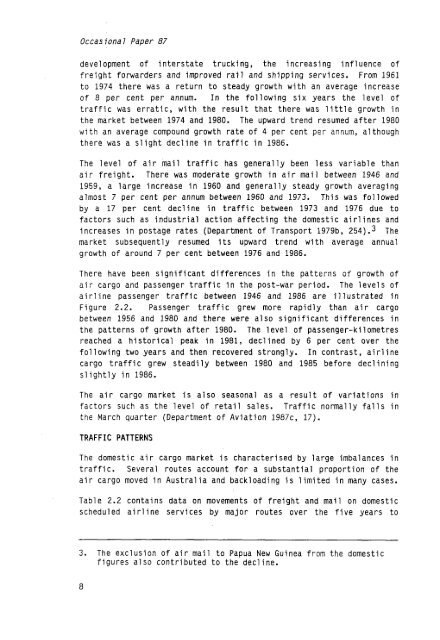Domestic Air Cargo Industry in Australia - Bureau of Infrastructure ...
Domestic Air Cargo Industry in Australia - Bureau of Infrastructure ...
Domestic Air Cargo Industry in Australia - Bureau of Infrastructure ...
You also want an ePaper? Increase the reach of your titles
YUMPU automatically turns print PDFs into web optimized ePapers that Google loves.
Occasional Paper 87development <strong>of</strong> <strong>in</strong>terstate truck<strong>in</strong>g, the <strong>in</strong>creas<strong>in</strong>g <strong>in</strong>fluence <strong>of</strong>freight forwarders and improved rail and shipp<strong>in</strong>g services. From 1961to 1974 there was a return to steady growth with an average <strong>in</strong>crease<strong>of</strong> 8 per cent per annum. In the follow<strong>in</strong>g six years the level <strong>of</strong>traffic was erratic, with the result that there was little growth <strong>in</strong>the market between 1974 and 1980. The upward trend resumed after 1980with an average compound growth rate <strong>of</strong> 4 per cent per annum, althoughthere was a slight decl<strong>in</strong>e <strong>in</strong> traffic <strong>in</strong> 1986.The level <strong>of</strong> air mail traffic has generally been less variable thanair freight. There was moderate growth <strong>in</strong> air mail between 1946 and1959, a large <strong>in</strong>crease <strong>in</strong> 1960 and generally steady growth averag<strong>in</strong>galmost 7 per cent per annum between 1960 and 1973. This was followedby a 17 per cent decl<strong>in</strong>e <strong>in</strong> traffic between 1973 and 1976 due t<strong>of</strong>actors such as <strong>in</strong>dustrial action affect<strong>in</strong>g the domestic airl<strong>in</strong>es and<strong>in</strong>creases <strong>in</strong> postage rates (Department <strong>of</strong> Transport 1979b, 254) .3 Themarket subsequently resumed its upward trend with averageannualgrowth <strong>of</strong> around 7 per cent between 1976 and 1986.There have been significant differences <strong>in</strong> the patterns <strong>of</strong> growth <strong>of</strong>air cargo and passenger traffic <strong>in</strong> the post-war period. The levels <strong>of</strong>airl<strong>in</strong>e passenger traffic between 1946 and 1986 are illustrated <strong>in</strong>Figure 2.2. Passenger traffic grew more rapidly than air cargobetween 1956 and 1980 and there were also significant differences <strong>in</strong>the patterns <strong>of</strong> growth after 1980. The level <strong>of</strong> passenger-kilometresreached a historical peak <strong>in</strong> 1981, decl <strong>in</strong>ed by 6 per cent over thefollow<strong>in</strong>g two years and then recovered strongly. In contrast, airl<strong>in</strong>ecargo traffic grew steadily between 1980 and 1985 before decl<strong>in</strong><strong>in</strong>gslightly <strong>in</strong> 1986.The air cargo market is also seasonal as a result <strong>of</strong> variations <strong>in</strong>factors such as the level <strong>of</strong> retail sales. Traffic normally falls <strong>in</strong>the March quarter (Department <strong>of</strong> Aviation 1987c, 17).TRAFFIC PATTERNSThe domestic air cargo market is characterised by large imbalances <strong>in</strong>traffic. Several routes account for a substantial proportion <strong>of</strong> theair cargo moved <strong>in</strong> <strong>Australia</strong> and backload<strong>in</strong>g is limited <strong>in</strong> many cases.Table 2.2 conta<strong>in</strong>s data on movements <strong>of</strong> freight and mail on domesticscheduled airl<strong>in</strong>e services by major routes over the five years to3. The exclusion <strong>of</strong> air mail to Papua New Gu<strong>in</strong>ea from the domesticfigures also contributed to the decl<strong>in</strong>e.8
















